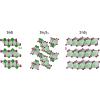当前位置:
X-MOL 学术
›
Phys. Rev. Materials
›
论文详情
Our official English website, www.x-mol.net, welcomes your feedback! (Note: you will need to create a separate account there.)
Sn5s2lone pairs and the electronic structure of tin sulphides: A photoreflectance, high-energy photoemission, and theoretical investigation
Physical Review Materials ( IF 3.4 ) Pub Date : 2020-07-02 , DOI: 10.1103/physrevmaterials.4.074602 Leanne A. H. Jones , Wojciech M. Linhart , Nicole Fleck , Jack E. N. Swallow , Philip A. E. Murgatroyd , Huw Shiel , Thomas J. Featherstone , Matthew J. Smiles , Pardeep K. Thakur , Tien-Lin Lee , Laurence J. Hardwick , Jonathan Alaria , Frank Jäckel , Robert Kudrawiec , Lee A. Burton , Aron Walsh , Jonathan M. Skelton , Tim D. Veal , Vin R. Dhanak
Physical Review Materials ( IF 3.4 ) Pub Date : 2020-07-02 , DOI: 10.1103/physrevmaterials.4.074602 Leanne A. H. Jones , Wojciech M. Linhart , Nicole Fleck , Jack E. N. Swallow , Philip A. E. Murgatroyd , Huw Shiel , Thomas J. Featherstone , Matthew J. Smiles , Pardeep K. Thakur , Tien-Lin Lee , Laurence J. Hardwick , Jonathan Alaria , Frank Jäckel , Robert Kudrawiec , Lee A. Burton , Aron Walsh , Jonathan M. Skelton , Tim D. Veal , Vin R. Dhanak

|
The effects of Sn lone pairs in the different phases of Sn sulphides are investigated with photoreflectance, hard x-ray photoemission spectroscopy (HAXPES), and density functional theory. Due to the photon energy-dependence of the photoionization cross sections, at high photon energy, the Sn orbital photoemission has increased intensity relative to that from other orbitals. This enables the Sn state contribution at the top of the valence band in the different Sn-sulphides, SnS, , and , to be clearly identified. SnS and contain Sn(II) cations and the corresponding Sn lone pairs are at the valence band maximum (VBM), leading to –1.3 eV band gaps and relatively high VBM on an absolute energy scale. In contrast, only contains Sn(IV) cations, no filled lone pairs, and therefore has a eV room-temperature band gap and much lower VBM compared with SnS and . The direct band gaps of these materials at 20 K are found using photoreflectance to be 1.36, 1.08, and 2.47 eV for SnS, , and , respectively, which further highlights the effect of having the lone-pair states at the VBM. As well as elucidating the role of the Sn lone pairs in determining the band gaps and band alignments of the family of Sn-sulphide compounds, this also highlights how HAXPES is an ideal method for probing the lone-pair contribution to the density of states of the emerging class of materials with configuration.
中文翻译:

Sn5s2lone对和硫化锡的电子结构:光反射,高能光发射和理论研究
锡的影响 利用光反射,硬X射线光发射光谱(HAXPES)和密度泛函理论研究了锡硫化物不同相中的孤对。由于光电离截面的光子能量依赖性,在高光子能量下,Sn相对于其他轨道,轨道光发射的强度有所增加。这使锡 不同Sn硫化物SnS在价带顶部的状态贡献, 和 ,以便明确识别。锡和 包含Sn(II)阳离子和相应的Sn 孤对在价带最大值(VBM),导致 –1.3 eV带隙和绝对能量规模上较高的VBM。相反, 仅包含Sn(IV)阳离子,没有填充的孤对,因此具有 eV室温带隙和与SnS和 。使用光反射法发现,对于SnS,这些材料在20 K时的直接带隙为1.36、1.08和2.47 eV,和 分别进一步突出了在VBM处具有孤对状态的影响。以及阐明锡的作用 孤对在确定Sn硫化物族的带隙和能带排列中的作用,这也凸显了HAXPES是探索孤对对新兴材料态密度的贡献的理想方法。 组态。
更新日期:2020-07-02
中文翻译:

Sn5s2lone对和硫化锡的电子结构:光反射,高能光发射和理论研究
锡的影响 利用光反射,硬X射线光发射光谱(HAXPES)和密度泛函理论研究了锡硫化物不同相中的孤对。由于光电离截面的光子能量依赖性,在高光子能量下,Sn相对于其他轨道,轨道光发射的强度有所增加。这使锡 不同Sn硫化物SnS在价带顶部的状态贡献, 和 ,以便明确识别。锡和 包含Sn(II)阳离子和相应的Sn 孤对在价带最大值(VBM),导致 –1.3 eV带隙和绝对能量规模上较高的VBM。相反, 仅包含Sn(IV)阳离子,没有填充的孤对,因此具有 eV室温带隙和与SnS和 。使用光反射法发现,对于SnS,这些材料在20 K时的直接带隙为1.36、1.08和2.47 eV,和 分别进一步突出了在VBM处具有孤对状态的影响。以及阐明锡的作用 孤对在确定Sn硫化物族的带隙和能带排列中的作用,这也凸显了HAXPES是探索孤对对新兴材料态密度的贡献的理想方法。 组态。



























 京公网安备 11010802027423号
京公网安备 11010802027423号